
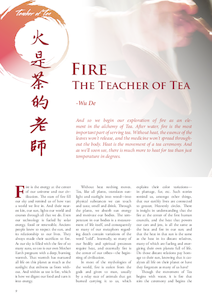 |
|
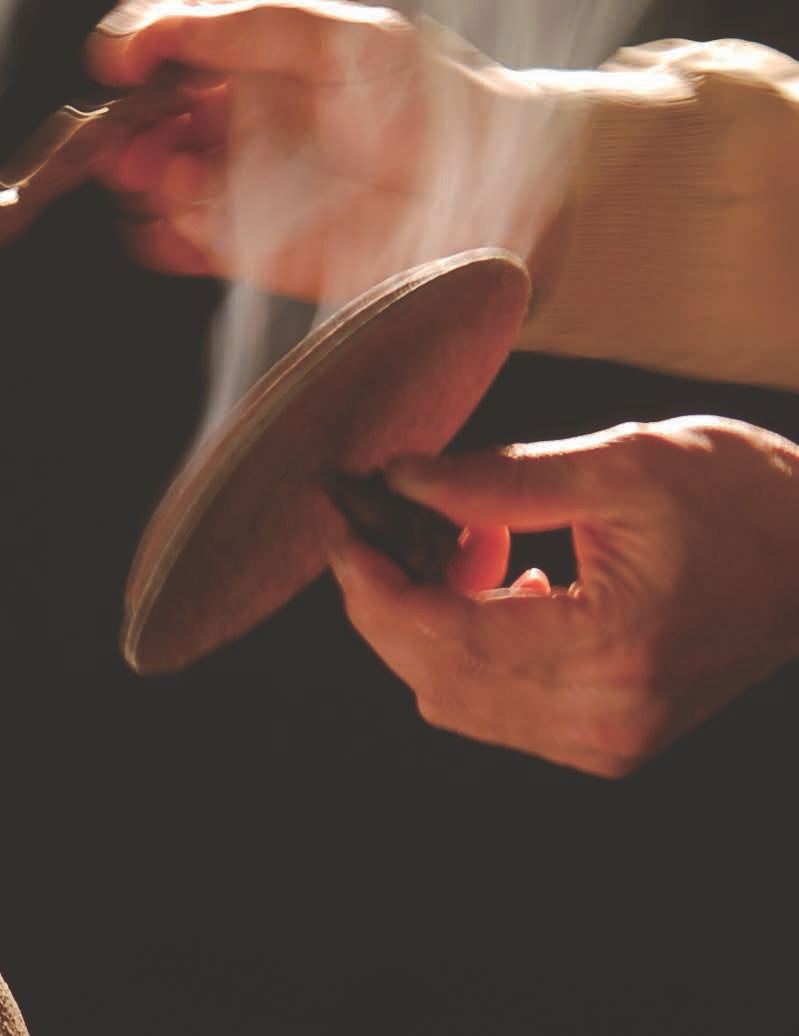
Fire is the energy at the center of our universe and our civilization. The stars of fire fill our sky and remind us of how vast a world we live in. And their nearest kin, our sun, lights our world and courses through all that we do. Even our technology is fueled by solar energy, fossil or renewable. Ancient people knew to respect the sun, and its relationship to our lives. They always made their sacrifices to fire. As our sky is filled with the fire of so many suns, so too is our own Mother Earth pregnant with a deep, burning warmth. That warmth has nurtured all life on this planet as much as the sunlight that enlivens us from without. And within us too is fire, which is how we digest our food and turn it into energy.
Without heat nothing moves. Tea, like all plants, translates sunlight and starlight into wood - into physical substances we can touch and taste, smell and drink. Through the plants, we absorb sun energy and motivate our bodies. The temperature in our bodies is a measurement of life itself, and consequently so many of our metaphors regarding death contain variations of the word "cold". Internally, so many of our bodily and spiritual processes require heat, and externally fire is the center of our tribes - the beginning of civilization.
In most of the mythologies of the world, fire is stolen from the gods and given to man, usually by a relay race of animals that get burned carrying it to us, which explains their color variations - in plumage, fur, etc. Such stories remind us, amongst other things, that our earthly lives are connected to greater, Heavenly circles. There is insight in understanding that the fire at the center of the first human councils, and the heat that powers our cars and jets, is all the same as the heat and fire in our sun; and that the heat in that sun is the same as the heat in its distant relatives, many of which are fueling and energizing their own planets full of life. Do those distant relations pay homage to their sun, knowing that it catalyzes all life on their planet or have they forgotten as many of us have?
Though the movement of Tea begins with water, it is fire that stirs the ceremony and begins the alchemy. Imagine the tea ceremony as a dance: the water is the quiet rolling that begins. A hush so fluidly lifts us into its quiet embrace, as the dancer and her music gently drift onto the stage. But it is only when she meets the first surge of energy, and the music rises in tempo and grace that the magical alchemy of music-to-dance begins. A rhythm ensues between the water and fire, and when it peaks we will introduce it to the tea.
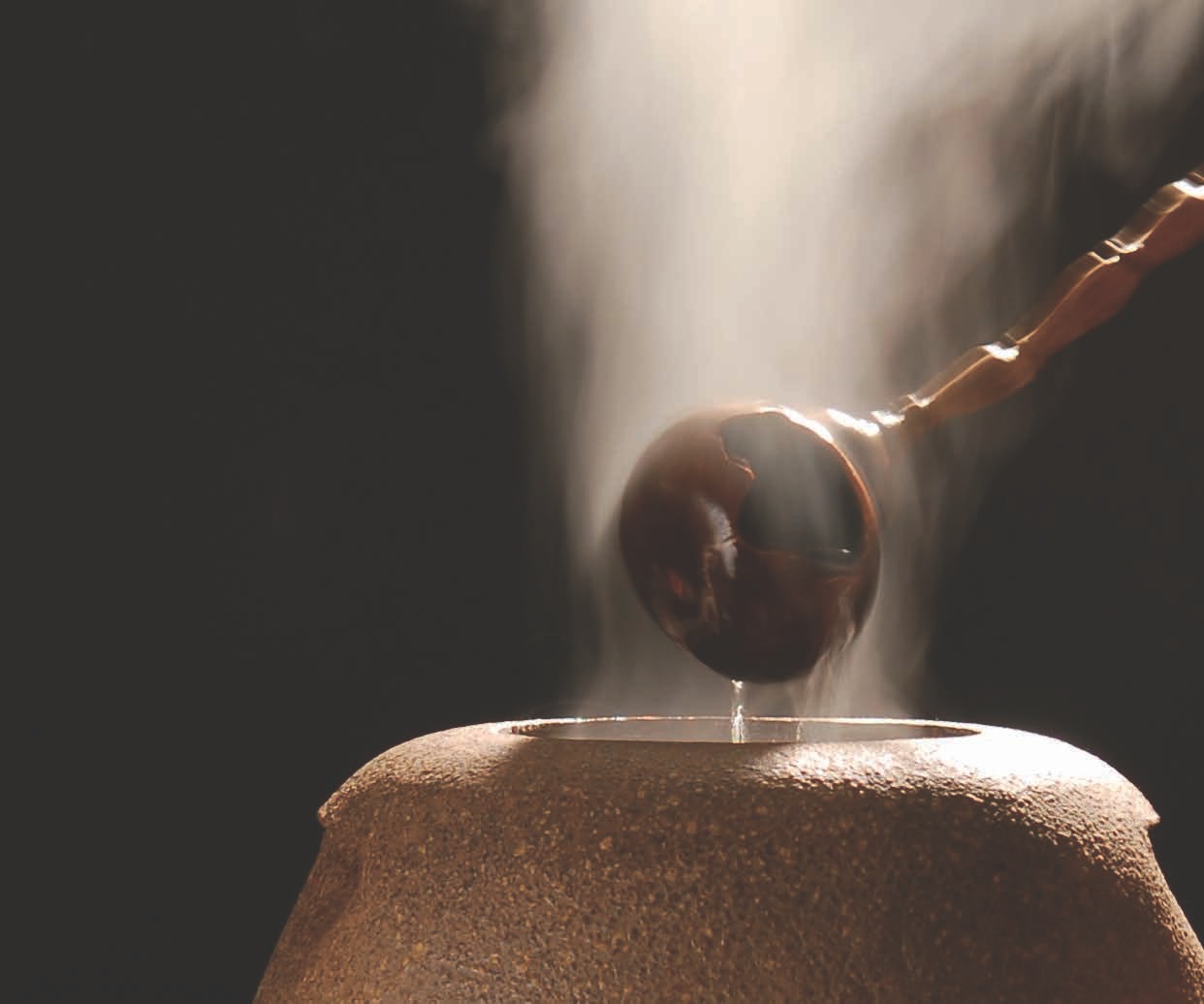
The tea has known temperature before. It was once a leaf on a tree, gathering sun and water through its stem. It has since been in meditation, resting without the air, temperature and water that once meant life for it. Now, we will resurrect it, returning the sun, water and air to it through the boiled water. For an old tea, it's a long time coming.
Fire is the conveyer of Tea. Without it, Tea cannot give its essence to us. Without heat in the water, the Qi is not released and conveyed to us. Also, as the tea reaches our bodies, it is the heat that allows it to spread to our extremities and communicate with our whole selves. Heat disperses the energy of Tea, releasing its fragrance and flavor as well as its soul.
Remember the poem that expresses the four principles of gongfu tea, as handed down in this tradition? We have discussed it in our gongfu tea tips articles often. As you can see, only one of the lines really has to do with external principles, and that is the first, which essentially means: maintain temperature throughout. This means that the temperature should not change from the kettle to the guests' mouths. That is way harder than you'd think; and like most ancient gongfu principles, it takes layers upon layers of work and skill to get to the point where temperature can be steady throughout a tea ceremony.
Preserve the heat and begin to absorb peace, With slow, gentle, graceful movements, And a heart free from obstructions, Everything is finished in one breath.
Ideally, the heat for tea should be quick and Spartan, allowing the water to retain its essence as it transforms in this way. If the heating process takes too long, the water is over-cooked and flattens, losing much of its magic. (Over-boiling also causes such flatness.) As any tea lover who experiments with heat sources knows, there is so much more to heat than just temperature, especially when it comes to boiling water for Tea. The way the heat penetrates the leaves and extracts the liquor is very different using different heat sources. Why does water from charcoal feel so much hotter even when the temperature is the same? And is there not a sense of depth to heat? Is there a difference when the heat source is even/uniform? Or how about how quickly the water is heated up? All of these issues and more are beyond just the temperature of the water. Consequently, the exploration of fire for tea is more than just heat; it is elemental. There is a lot more for the Chajin to explore than just the temperature of the water in degrees, which is only one factor in fire, the Teacher of Tea.
There are many kinds of heat in this modern world, and each has to be weighed in terms of alchemy and suitability for tea, as well as convenience. Last month we talked about sourcing water for tea, which is similar in a lot of ways. We have to face the facts that much of the natural water sources around these days are polluted and we can't try our teas with rain, snow and river waters to see which is better the way past tea sages could. We sometimes have to settle for what we can find, which is different for all of us depending on our living conditions. Just because you can't fetch spring water every week, or use charcoal for every session (because you live in the city, for example), doesn't mean that you still shouldn't do so every now and again on special occasions; or that you can't find other ways to put more heart, attention and love into your tea practice!
We share our experience with different kinds of heat for tea so that you can learn, explore and further your tea knowledge. All teachings are always and ever invitations to explore. Tea is a path of self-cultivation. The best tea is tea prepared with love, from the heart. And that has nothing to do with what kind of heat source you use. This article is not an exercise in snobbish judgment. As we progress on our tea journey, we naturally seek out finer tea and tea brewing methodology to bring out the best in our tea and to create sacred ceremonies that transform others. When we're starting out, however, it's best to keep in mind that tea is just leaves, water and heat. Heat your water with the love in your heart, and you are sure to find the best source of heat for you.
The plus side of an electric heat source is that you can control temperature very easily and consistently when heating water, and it is quick and convenient. The downside is that you are then using electric heat to power your tea ceremony rather than actual fire, and therefore lose one of the five elements. Here are the varieties of electric heat for tea:
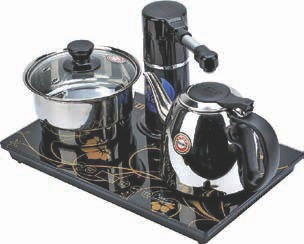
Induction: Many electric water heaters use induction to heat the water, which is a way of reversing electromagnetic currents to create heat. While such devices are convenient and incredibly fast and efficient, they also spoil the water. Some of the energy gets in the water and changes the energetic structure. I, therefore, wouldn't recommend using them unless convenience and speed outweigh other parameters. Using induction devices with spring water basically deflates its Qi. In many ways, induction heaters are akin to microwaving food: it is fast and convenient, but not the same as properly cooked food in some essential ways. It is not a natural heat, and this will be felt by the sensitive tea lover, especially when you compare such water with water prepared on other heat sources, even electric ones. Some of the water's spirit is lost. Induction heaters come as plates, kettles or kettle/base sets. Some of them even impart a flavor into the water. Also, as an aside, these induction heaters are often cheaply made and rarely last for years; and sometimes they're made of sketchy plastic, etc. (though there are nicer induction kettles that you can find which are well made and a nice long-term teaware).
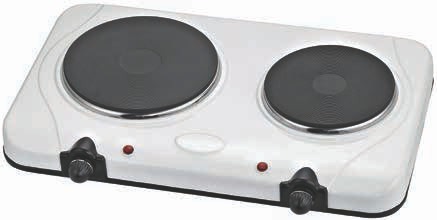
Iron hot plates: These electric plates are simpler than induction plates or kettles. An element heats up an iron or Teflon plate, which then heats your kettle. These are usually built stronger, last longer and make better water than induction plates or kettles. They aren't as quick as induction, but the water will be smoother and brighter. Hot plates are also very convenient; with dials so you can boil the water and then turn the heat down to keep it warm throughout a session. If you are going to get a hot plate, we recommend real iron as opposed to coated, man-made hotplate (Teflon). The iron will make nicer water for tea. We find that German companies make excellent and affordable iron hot plates that last forever. We have a Vastar at the center, which is a Taiwanese company that produces its hot plates in Germany.

Japanese electric braziers: In the 1970's, the modernization of the tea ceremony in Japan meant preparing tea in places where charcoal was no longer a viable option. Tea lovers invented braziers with electric coils in them that wrap around pieces of artificial charcoal to give the appearance of a charcoal arrangement. While these coils can be slow if you have a big kettle, they make nice water and look great for an electric heat source. The element is often housed in a bronze or ceramic brazier and can look gorgeous in a tea space.
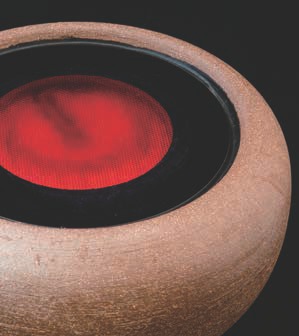
Infrared: Infrared plates make very nice water, as close to charcoal as we have found in an electric device. In fact, the heat in charcoal is essentially infrared as well. This technology is also convenient, fast and has a dial to control temperature, but makes water that is comparable to a real flame. Infrared plates can be cheap or expensive, depending on the wattage and the style. You will want to get one with the highest wattage possible to heat the water as quickly as you can. In Taiwan, there are nice infrared plates that are sealed into handmade clay braziers. We have several in the center and often recommend them to guests.

Gas and alcohol are a slight step up from electric heat sources. These stoves at least have a real flame, closer to fire in its elemental form. Though heat and fire are related, there is something very different about them. Elemental fire changes everything. Most people can tell the difference between a room heated by a fireplace and one heated by an electric radiator, just as we can distinguish between water heated on fire and that on electric burners. Alcohol burners are more for maintaining heat than for bringing the water to a boil. If you have one of those, you will want to heat the water on a gas stove and then use the alcohol burner to maintain the heat.
You can either use a gas camp stove and seat it next to you while you serve tea, using a higher flame to boil and a lower flame to maintain temperature, or you can boil your kettle on gas and then use an alcohol burner by your side to keep the kettle warm. If you have two kettles, a gas stove and an alcohol burner, you can make endless water for the largest of groups. This is always our setup when we do events out in the world: one kettle boiling on the gas and the other staying warm on the alcohol burner. To do larger and larger events, you just need to add gas stoves and kettles. The downside to such camp stoves is that they use up gas cans, which aren't good for the environment long-term. If you are going to use gas at home, it's better to boil on the stove and then carry the water to an alcohol burner. Alcohol is inexpensive and lasts a long time, since the flame is small.
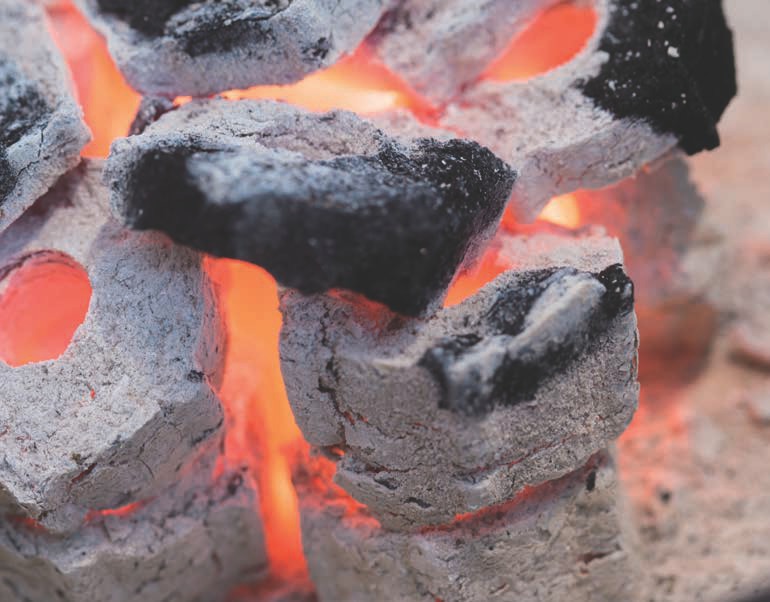
The ideal way to heat water for tea is to use charcoal. Charcoal has infrared energy, like the sun. It returns that energy to the tea. We aren't sure of the scientific reason why, nor is it necessary for us to figure it out, but water prepared on charcoal steams much more than other water, even if they are the same exact temperature. Also, we have done experiments heating water on electric and charcoal to exactly equal temperatures and then found that everyone present could still distinguish the water heated on charcoal as being hotter and brighter. Sometimes we use the adjective "ionic", though not in any proper scientific way. We mean that the heat seems elemental, like it is in each of the atoms at their core. It feels as if more of the water's substance is infused with heat. Such heat penetrates deeper into the tea, and then into us when we drink the liquor. The heat is penetrating, extracting and then conveying more of the tea's essence to us.
Our Japanese master said that a Chajin who wishes to understand charcoal should keep their coals going for three years. At the end of that time, they'll be an expert. That is a bit hard for most people. Don't be intimidated by charcoal. We suggest starting with a simple brazier and smokeless, non-toxic charcoal. Here in Taiwan, we start students out with a smokeless coal made of compressed coconut husks. It is good because all the pieces light uniformly and are all the same shape, which makes arranging them easier than the natural kinds of coal. Better, hardwood charcoals will burn with a more lively flame, and heat the water quicker. One of our favorites comes from the dragon eye fruit tree (long yan). Later in this issue, we will go through all the different kinds of charcoal we use here at the Hut, as well as the different kinds of braziers and charcoal implements.
You should try to experience, harness and master the heat in Tea. Harnessing heat was a huge step in human evolution. We must respect fire, and not assume we create it. Rather, we invite it into our Tea and bodies. If it is not harnessed with respect, fire can be very destructive. In order to experience the fire element in Tea more deeply, you should learn to experience it on as many levels as possible. This means gauging temperature with your senses rather than using a thermometer.
Fire is a huge aspect of Tea and life. There is so much to explore looking into its swirling depths when you are camping, or seeing it twinkle in the distant stars that map our sky. Most essentially, we can feel it burning from within the center of our Earth and the center of our bodies. When we drink tea, we can look inward at the temperature as it flows in currents that awaken us, and connect us to all these greater circles around us...
